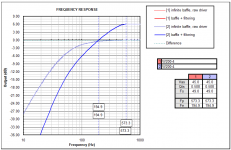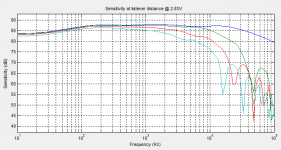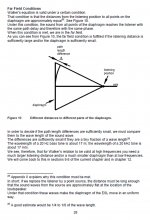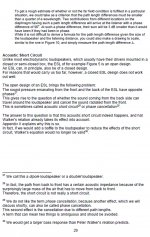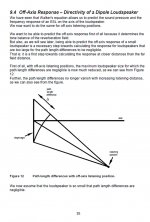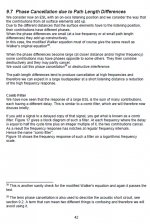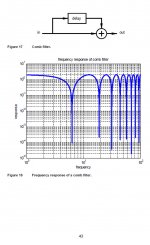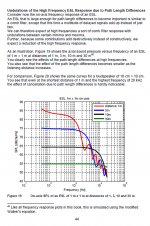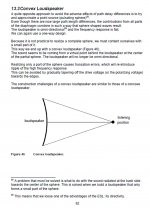I have read reviews of commercial ESL speakers, and it seems the general consensus is that bigger panels sound better. This is especially true among the folks that review and compare within one company, such as Martin Logan.
When people say they "sound better", they typically use subjective terms like "bigger soundstage", "room-filling sound", "larger sweet spot", "more dynamic", etc.
Does anybody have any objective or technical reasons for the perceived difference in sound between a big panel and a little one?
I briefly looked over some ESL building guides, which talked of things like phase cancellations and dispersion and etc. They seem to suggest either a dinky little panel, leaving something else to handle the bass, or a very tall "line source" type panel. Now if line source is the ideal, then I could kind of guess as to why a taller panel sounds better than a shorter one. Perhaps because it sprays sound over a larger area, and not just directly at ear height, that this other sound bounces around the room and improves the "ambiance"?
In terms of the width, is wider mainly to go lower in frequency? And if there will exist a woofer to take care of low frequencies, is there any benefit to going wider (in terms of improvement in sound quality)?
When people say they "sound better", they typically use subjective terms like "bigger soundstage", "room-filling sound", "larger sweet spot", "more dynamic", etc.
Does anybody have any objective or technical reasons for the perceived difference in sound between a big panel and a little one?
I briefly looked over some ESL building guides, which talked of things like phase cancellations and dispersion and etc. They seem to suggest either a dinky little panel, leaving something else to handle the bass, or a very tall "line source" type panel. Now if line source is the ideal, then I could kind of guess as to why a taller panel sounds better than a shorter one. Perhaps because it sprays sound over a larger area, and not just directly at ear height, that this other sound bounces around the room and improves the "ambiance"?
In terms of the width, is wider mainly to go lower in frequency? And if there will exist a woofer to take care of low frequencies, is there any benefit to going wider (in terms of improvement in sound quality)?
What I have found with logans.... are any non-flat ESL panel... logans are 30% crived................is yes the larger panels can sound better
because you hear more of a flat panel sound.... an can go a littel lower..............i have 16", 12" an 9" logan panels....all reworkert with new bias feeds......so i get about 3db more output than stock......the 16" wide sound better to me because...thay sound more like a flat panel....................the 9" is the sweest an imeges best.....but crossover at like 4-500hz.....the 16" at about 230hz.....
But the Acoustats M3s i have setup... 3, 9" panels ea... flat sound better.... an the quad 57s.....are flat some say are one of the best ever made....
Go here if you have not............i think Mr Sanders has got it right....well like all things for me anyway.....have fun with ESLs...
Long live Acoustats...........
because you hear more of a flat panel sound.... an can go a littel lower..............i have 16", 12" an 9" logan panels....all reworkert with new bias feeds......so i get about 3db more output than stock......the 16" wide sound better to me because...thay sound more like a flat panel....................the 9" is the sweest an imeges best.....but crossover at like 4-500hz.....the 16" at about 230hz.....
But the Acoustats M3s i have setup... 3, 9" panels ea... flat sound better.... an the quad 57s.....are flat some say are one of the best ever made....
Go here if you have not............i think Mr Sanders has got it right....well like all things for me anyway.....have fun with ESLs...
Long live Acoustats...........
Last edited:
It's complete nonsense to say this.
Back to esl:
Large esl have normaly a lower resonance frequency, can be used at a lower frequency.
In my opinion a hybride esl is never a good solution, so i like large full range esl units.
Because of the large capacity, impedance, derectivity i also like a electrical segmentated esl.
I have had a very large esl (60cm x 200cm) and the only reason that i made it smaller is that i didn't want such a large esl in my room any more. It sounded wonderfull with very good bass.
Maybe for the same reason some folks like tubes and vinyl records: less treble.
Ben
Back to esl:
Large esl have normaly a lower resonance frequency, can be used at a lower frequency.
In my opinion a hybride esl is never a good solution, so i like large full range esl units.
Because of the large capacity, impedance, derectivity i also like a electrical segmentated esl.
I have had a very large esl (60cm x 200cm) and the only reason that i made it smaller is that i didn't want such a large esl in my room any more. It sounded wonderfull with very good bass.
Last edited:
Hi,
don't be upset, but I have a totally different opinion ... only a Hybrid will be a complete sound system.
The inherent drawbacks regarding efficiency and high Q limit fullrangers to a high degree. This leads for example to the problem of how to balance the lowmid suckout against the high-Q bass resonance. Imho its especially the quality and balance in the lowmids and upper bass that makes the difference between HiFi and Music.
Too low volume in that range and the system sounds anemic, with a technical note. In other words there's linear distortion.
The right volume and the system comes to life, sounding more authentic and real. If You play the panels of Hybrids alone and wo. xover You will immideately notice that larger and wider panels can put out alot of energy just in that lowmid range. This energy finds it way directly into Your guts and chest and creates a lifelike impression.
I don't think, that it is a matter of distribution spreading or an other measurable parameter, at least I don' know of a plausible explantion.
jauu
Calvin
don't be upset, but I have a totally different opinion ... only a Hybrid will be a complete sound system.
The inherent drawbacks regarding efficiency and high Q limit fullrangers to a high degree. This leads for example to the problem of how to balance the lowmid suckout against the high-Q bass resonance. Imho its especially the quality and balance in the lowmids and upper bass that makes the difference between HiFi and Music.
Too low volume in that range and the system sounds anemic, with a technical note. In other words there's linear distortion.
The right volume and the system comes to life, sounding more authentic and real. If You play the panels of Hybrids alone and wo. xover You will immideately notice that larger and wider panels can put out alot of energy just in that lowmid range. This energy finds it way directly into Your guts and chest and creates a lifelike impression.
I don't think, that it is a matter of distribution spreading or an other measurable parameter, at least I don' know of a plausible explantion.
jauu
Calvin
The bigger the radiating area, the more directional, which means less coloration from room reflections on many axis. Since you're talking about dipole radiators, there's that fairly strong reflection off the front wall of the listening room from the backwave. Such speakers need to be out from that front wall (and any walls) at least 3 feet for the psycho-acoustic effect to be desirable. I researched, designed and built some high end open baffle speakers so know all about this. The backwave technically adds a coloration, but also seems to give embedded reverbs a 3 dimensional feel, perhaps by recreating lower midrange timing cues that were lost with inter-aural crosstalk.
ESL panels, like all panels, have limited physical dynamic range, and therefore are not very good with bass frequencies. Many are supplimented with an electrodynamic woofer at the bottom. Woofer placement can be challenging with room acoustics as they are. There's a lot of talk about how the woofers aren't fast enough to keep up with the speed of the panels. The problem is much more likely about the listening room acoustics in my opinion. When you get down below about 200HZ, a half wavelength of the acoustic signal starts to fit between the parallel walls of the typical listening room. Then the room rings, creating a sense of delay. That adds to the delay of the crossover, which if it's a 4 pole and at 100HZ will give about a 10mS delay by itself. Not ideal, but maybe the best anyone can do.
With highly directional speakers, the sweet spot is usually small, but imaging can be very good in the upper midrange frequencies. With dipoles at least 3 ft away from any walls, the sweet spot can be larger in the lower midrange depending on the room acoustics.
ESL panels, like all panels, have limited physical dynamic range, and therefore are not very good with bass frequencies. Many are supplimented with an electrodynamic woofer at the bottom. Woofer placement can be challenging with room acoustics as they are. There's a lot of talk about how the woofers aren't fast enough to keep up with the speed of the panels. The problem is much more likely about the listening room acoustics in my opinion. When you get down below about 200HZ, a half wavelength of the acoustic signal starts to fit between the parallel walls of the typical listening room. Then the room rings, creating a sense of delay. That adds to the delay of the crossover, which if it's a 4 pole and at 100HZ will give about a 10mS delay by itself. Not ideal, but maybe the best anyone can do.
With highly directional speakers, the sweet spot is usually small, but imaging can be very good in the upper midrange frequencies. With dipoles at least 3 ft away from any walls, the sweet spot can be larger in the lower midrange depending on the room acoustics.
The bigger the radiating area, the more directional, which means less coloration from room reflections on many axis. Since you're talking about dipole radiators, there's that fairly strong reflection off the front wall of the listening room from the backwave. Such speakers need to be out from that front wall (and any walls) at least 3 feet for the psycho-acoustic effect to be desirable. I researched, designed and built some high end open baffle speakers so know all about this. The backwave technically adds a coloration, but also seems to give embedded reverbs a 3 dimensional feel, perhaps by recreating lower midrange timing cues that were lost with inter-aural crosstalk.
ESL panels, like all panels, have limited physical dynamic range, and therefore are not very good with bass frequencies. Many are supplimented with an electrodynamic woofer at the bottom. Woofer placement can be challenging with room acoustics as they are. There's a lot of talk about how the woofers aren't fast enough to keep up with the speed of the panels. The problem is much more likely about the listening room acoustics in my opinion. When you get down below about 200HZ, a half wavelength of the acoustic signal starts to fit between the parallel walls of the typical listening room. Then the room rings, creating a sense of delay. That adds to the delay of the crossover, which if it's a 4 pole and at 100HZ will give about a 10mS delay by itself. Not ideal, but maybe the best anyone can do.
With highly directional speakers, the sweet spot is usually small, but imaging can be very good in the upper midrange frequencies. With dipoles at least 3 ft away from any walls, the sweet spot can be larger in the lower midrange depending on the room acoustics.
It depends from the frequency. If you do a electrical segmentation you get a more constant directivity.
Hi,
don't be upset, but I have a totally different opinion ... only a Hybrid will be a complete sound system.
The inherent drawbacks regarding efficiency and high Q limit fullrangers to a high degree. This leads for example to the problem of how to balance the lowmid suckout against the high-Q bass resonance. Imho its especially the quality and balance in the lowmids and upper bass that makes the difference between HiFi and Music.
Too low volume in that range and the system sounds anemic, with a technical note. In other words there's linear distortion.
The right volume and the system comes to life, sounding more authentic and real. If You play the panels of Hybrids alone and wo. xover You will immideately notice that larger and wider panels can put out alot of energy just in that lowmid range. This energy finds it way directly into Your guts and chest and creates a lifelike impression.
I don't think, that it is a matter of distribution spreading or an other measurable parameter, at least I don' know of a plausible explantion.
jauu
Calvin
Hi,
I know your negative bias against full range ESL but IMO there is no all round solution. I have done many experiments with my ESL system and,although it was initially designed as hybrid crossed at around 100Hz, I like the sound of full range mode much better. Nowhere near as boomy as a monopole sub or difficult to position like dipole sub.
IMO a lot depends how a full range ESL is done. Damping mesh can be added to control fundamental and active eq of few db is not difficult to implement either. It can mean difference between bad bass and good bass.
Sensitivity problems can be solved by using large area and not every one wants to damage their ears
I have had a very large esl (60cm x 200cm) and the only reason that i made it smaller is that i didn't want such a large esl in my room any more. It sounded wonderfull with very good bass.
Wow that's big. Have you used single panel or multiple small units? What was exact radiating area? Sensitivity?
Regards,
Lukas.
Yes, at low frequencies there will be significant diffraction, so they lose their directionality.It depends from the frequency. If you do a electrical segmentation you get a more constant directivity.
Imho its especially the quality and balance in the lowmids and upper bass that makes the difference between HiFi and Music.
Too low volume in that range and the system sounds anemic, with a technical note. In other words there's linear distortion.
The right volume and the system comes to life, sounding more authentic and real. If You play the panels of Hybrids alone and wo. xover You will immideately notice that larger and wider panels can put out alot of energy just in that lowmid range. This energy finds it way directly into Your guts and chest and creates a lifelike impression.
I don't think, that it is a matter of distribution spreading or an other measurable parameter, at least I don' know of a plausible explantion.
The way you say it, it sounds like just an equilization problem. But both the little low end and big high end Martin Logan speakers claim to measure fairly flat. And the low end speakers cross over at 500 Hz, and the medium end cross over only a little lower (maybe 450 hz), yet people still claim the medium end sounds better for some reason or another.
Last edited:
The bigger the radiating area, the more directional, which means less coloration from room reflections on many axis.
1. That seems to be Sander's approach in going back to flat panels. But if directional is what you want, why not have a smaller panel, but put some kind of sound absorbing aperture or baffles in front of the speaker to aim the sound right at your ears?
1a. And why would Martin Logan suggest you to toe out the speakers slightly instead of aiming right at your ears?
2. If less room reflections is the goal, then for a panel of the same width, a taller panel would be worse because it sprays sound at your knees, in addition to your ears. That extra sound will bounce around.
I have taken the approach of building narrower panels instead of wide ones.
I like their horizontal dispersion characteristics better.
I also have started to employ electrical segmentation in my latest build as well, I just haven't gotten the needed resistors yet.
I also use a bit more D/S than most, 1.85mm is what my new panel is set and may need to be increased a little, as this will allow for more output at the lowest frequency's than your typical panel made just for the midrange and higher with a typical D/S of 1/16".
I can get really good performance down to the 150hz to 250hz range just at the edge of diaphragm\stator clipping with a D/S of 2mm (3/32") and a width of 3.25" (and a 9.75" length) or so, and it is quite loud at this point (est. about >105db at 1 meter).
To compensate for this I use a much higher Bias voltage as well.
And higher transformation ratios (1:150-250) as well are possible increasing the overall efficiency using smaller area panels.
When the panels width equals one wavelength or greater than the frequency being produced, Then the dispersion starts to transition form a figure 8 pattern in to a narrow beam and keeps getting narrower as the frequency rises.
It also produces main smaller lobes off to the sides as well.
I have no issues of getting a high output from my little panels even down to the 200hz to 300hz range, providing that the stator coatings are up to the task of with holding such high voltages and there is plenty of D/S spacing.
At the lowest Frequency's the output level is directly related to diaphragm displacement and of course the dipole cancelling effect otherwise it would have a circular horzontal dispersion because the diaphragms width is much much less than one wavelength of the frequency being produced.
Wings can help with this and in a small setup I have found that it can increase the low end output by as much as 3db.
I have had better luck with not ruining the sound quality by using reflectors directly behind the diaphragm than I have had trying to dampen the backwave with some sort of absorbing material that is close the the diaphragm.
The back pressures created from anything within about 10"-12" from the diaphragm would reduce all of the finest details in sound that ESL's are so well known for, in my earlier experiments.
Using wings will help with the low end roll off as per dipole action, But the width of the diaphragm itself will determine the horizontal dispersion effects (beaming) for the higher freqeuncys.
And the more the displacement, This helps with the low end.
It is obvious as to why ML suggests to toe out there speakers!!
Its due to the delays and refraction issues of using a curved panel.
When using a taller panel in a line source arrangement the top and bottom reflections from the ceiling and the floor give the impression of having a larger room such as mirrors would do using light waves.
Giving an extension to a virtual room, If you will.
At least that is the way I understand it from reading a lot material on the subject.
Having any space from the ends of the driver to the ceiling and floor is when the reflections are refracted differently and unequally.
FWIW
jer
I like their horizontal dispersion characteristics better.
I also have started to employ electrical segmentation in my latest build as well, I just haven't gotten the needed resistors yet.
I also use a bit more D/S than most, 1.85mm is what my new panel is set and may need to be increased a little, as this will allow for more output at the lowest frequency's than your typical panel made just for the midrange and higher with a typical D/S of 1/16".
I can get really good performance down to the 150hz to 250hz range just at the edge of diaphragm\stator clipping with a D/S of 2mm (3/32") and a width of 3.25" (and a 9.75" length) or so, and it is quite loud at this point (est. about >105db at 1 meter).
To compensate for this I use a much higher Bias voltage as well.
And higher transformation ratios (1:150-250) as well are possible increasing the overall efficiency using smaller area panels.
When the panels width equals one wavelength or greater than the frequency being produced, Then the dispersion starts to transition form a figure 8 pattern in to a narrow beam and keeps getting narrower as the frequency rises.
It also produces main smaller lobes off to the sides as well.
I have no issues of getting a high output from my little panels even down to the 200hz to 300hz range, providing that the stator coatings are up to the task of with holding such high voltages and there is plenty of D/S spacing.
At the lowest Frequency's the output level is directly related to diaphragm displacement and of course the dipole cancelling effect otherwise it would have a circular horzontal dispersion because the diaphragms width is much much less than one wavelength of the frequency being produced.
Wings can help with this and in a small setup I have found that it can increase the low end output by as much as 3db.
I have had better luck with not ruining the sound quality by using reflectors directly behind the diaphragm than I have had trying to dampen the backwave with some sort of absorbing material that is close the the diaphragm.
The back pressures created from anything within about 10"-12" from the diaphragm would reduce all of the finest details in sound that ESL's are so well known for, in my earlier experiments.
Using wings will help with the low end roll off as per dipole action, But the width of the diaphragm itself will determine the horizontal dispersion effects (beaming) for the higher freqeuncys.
And the more the displacement, This helps with the low end.
It is obvious as to why ML suggests to toe out there speakers!!
Its due to the delays and refraction issues of using a curved panel.
When using a taller panel in a line source arrangement the top and bottom reflections from the ceiling and the floor give the impression of having a larger room such as mirrors would do using light waves.
Giving an extension to a virtual room, If you will.
At least that is the way I understand it from reading a lot material on the subject.
Having any space from the ends of the driver to the ceiling and floor is when the reflections are refracted differently and unequally.
FWIW
jer
Last edited:
Hi,
@Bazukaz:
A FR ESL also puts out a dipole bass, but the dynamic dipole is way more precise due to its Q beeing lower, closer to the optimal value, the vastly increased dynamic range and more compact size.
Sensitivity problems are not solved by sheer area, but rather the SPL increases and You might eventually sitting within the nearfield. -thereby solving the suckout prob in the lower mids, but exaggerating the bass resonance.
Adding damping required a frequency specific tool, that only cuts the bass resonance but wouldn´t effect the lower mids at the same.
So it must be something other than a damping felt/mat.
@beanbag:
In the freq-range below say 400Hz where larger/wider panels make a sonic difference neither the wide nor the thin panels beam, but radiate a widespread dipole-8.
I assume that differences in the typically higher xovered MLs are rather due to different basses as partners.
@gerald:
@Bazukaz:
... then use a dynamic dipole bass instead and position it close to the panel.Nowhere near as boomy as a monopole sub or difficult to position like dipole sub.
A FR ESL also puts out a dipole bass, but the dynamic dipole is way more precise due to its Q beeing lower, closer to the optimal value, the vastly increased dynamic range and more compact size.
Sensitivity problems are not solved by sheer area, but rather the SPL increases and You might eventually sitting within the nearfield. -thereby solving the suckout prob in the lower mids, but exaggerating the bass resonance.
Adding damping required a frequency specific tool, that only cuts the bass resonance but wouldn´t effect the lower mids at the same.
So it must be something other than a damping felt/mat.
@beanbag:
Yes it does, but it isn´t a matter of eq alone.... it sounds like just an equilization problem
In the freq-range below say 400Hz where larger/wider panels make a sonic difference neither the wide nor the thin panels beam, but radiate a widespread dipole-8.
I assume that differences in the typically higher xovered MLs are rather due to different basses as partners.
@gerald:
Could You elaborate? I don´t know what You mean with "delay" and "refraction". Certainly segmentation forms delays too.Its due to the delays and refraction issues of using a curved panel.
Hi,
It would be interesting to see claims of high SPL levels backed up by measurements(or simulation at least). I am curious what's the sensitivity of your dipole array at lets say 50 Hz(when equalization is not taken into account) ?
Attached is the simulation of frequency response of :
a) 8x Visaton W 200 drivers in a baffle 200x60 cm. Based on this sensitivity at 50 Hz is -15 dB or around 85 db/2.83V. heavy equalization is necessary as well as high powered amplifier. Peak SPL is limited by X,max rather than thermal power I guess.
b) Simulation of segmented ESL of the same size. As it can be seen sensitivity is more or less of similar level and even higher at lower frequencies not taking resonance into account. Perhaps it won't accept the same levels of input power like 8x dynamic drivers output can still be quite adequate, even for larger rooms.
Edit :
Max. combined displacement of a) case seems to be around 1.6 litters, compared to 1.2 litters in case of b). So there is no reason for ESL not to reach similar or even higher max. SPL, as it has more area and hence is more efficient mechanically.
Why not? Doubling area gives about 6dB more SPL and that's mostly in bass. The increase in SPL is not linear across audio range.
If the cause was displacement alone then only 3 dB were gained(as SPL = 10*log(P1/P2)). another 3 dB is gained by increased coupling to air and hence better mechanical efficiency.
While resonance is a significant problem with bare open ESL it can be significantly reduced. There were some measurements done by bolserst and it proves the mesh is quite effective:
http://www.diyaudio.com/forums/plan...con-dots-resonance-control-3.html#post1958582
In addition a speaker cover has a positive effect on damping as long as it's thin and light.
Regards,
Lukas.
Hi,
... then use a dynamic dipole bass instead and position it close to the panel.
A FR ESL also puts out a dipole bass, but the dynamic dipole is way more precise due to its Q beeing lower, closer to the optimal value, the vastly increased dynamic range and more compact size.
It would be interesting to see claims of high SPL levels backed up by measurements(or simulation at least). I am curious what's the sensitivity of your dipole array at lets say 50 Hz(when equalization is not taken into account) ?
Attached is the simulation of frequency response of :
a) 8x Visaton W 200 drivers in a baffle 200x60 cm. Based on this sensitivity at 50 Hz is -15 dB or around 85 db/2.83V. heavy equalization is necessary as well as high powered amplifier. Peak SPL is limited by X,max rather than thermal power I guess.
b) Simulation of segmented ESL of the same size. As it can be seen sensitivity is more or less of similar level and even higher at lower frequencies not taking resonance into account. Perhaps it won't accept the same levels of input power like 8x dynamic drivers output can still be quite adequate, even for larger rooms.
Edit :
Max. combined displacement of a) case seems to be around 1.6 litters, compared to 1.2 litters in case of b). So there is no reason for ESL not to reach similar or even higher max. SPL, as it has more area and hence is more efficient mechanically.
Sensitivity problems are not solved by sheer area, but rather the SPL increases and You might eventually sitting within the nearfield. -thereby solving the suckout prob in the lower mids, but exaggerating the bass resonance.
Why not? Doubling area gives about 6dB more SPL and that's mostly in bass. The increase in SPL is not linear across audio range.
If the cause was displacement alone then only 3 dB were gained(as SPL = 10*log(P1/P2)). another 3 dB is gained by increased coupling to air and hence better mechanical efficiency.
Adding damping required a frequency specific tool, that only cuts the bass resonance but wouldn´t effect the lower mids at the same.
So it must be something other than a damping felt/mat.
While resonance is a significant problem with bare open ESL it can be significantly reduced. There were some measurements done by bolserst and it proves the mesh is quite effective:
http://www.diyaudio.com/forums/plan...con-dots-resonance-control-3.html#post1958582
In addition a speaker cover has a positive effect on damping as long as it's thin and light.
Regards,
Lukas.
Attachments
Last edited:
Sanders Sound Systems Dispersion Whitepaper written by Roger Sanders.
Here the go here....... i tryed to put in my frist post..........have fun
Here the go here....... i tryed to put in my frist post..........have fun
I was referring to the Path length differences.
The phase differences can be greater in a curved panel than they are in a flat panel and still more so than the phase differences caused by the simple RC filter used for electrical segmentation.
Here are a few excerpt's from Frank Verwaal's paper that explains this, although it should be read in its full entirety for a complete understanding.
Elektrostatic Loudspeakers
jer
The phase differences can be greater in a curved panel than they are in a flat panel and still more so than the phase differences caused by the simple RC filter used for electrical segmentation.
Here are a few excerpt's from Frank Verwaal's paper that explains this, although it should be read in its full entirety for a complete understanding.
Elektrostatic Loudspeakers
jer
Attachments
I think active area was 175cm x 45cm. It was a wire stator with 7 electric segmentations. The foil 1 peace but with dots of silicon ( in later smaller models i did not used this dots anymore).
Hi,
I know your negative bias against full range ESL but IMO there is no all round solution. I have done many experiments with my ESL system and,although it was initially designed as hybrid crossed at around 100Hz, I like the sound of full range mode much better. Nowhere near as boomy as a monopole sub or difficult to position like dipole sub.
IMO a lot depends how a full range ESL is done. Damping mesh can be added to control fundamental and active eq of few db is not difficult to implement either. It can mean difference between bad bass and good bass.
Sensitivity problems can be solved by using large area and not every one wants to damage their ears
Wow that's big. Have you used single panel or multiple small units? What was exact radiating area? Sensitivity?
Regards,
Lukas.
Short version: Lower crossover point = More ESL glory, less cone woofer woofing...Does anybody have any objective or technical reasons for the perceived difference in sound between a big panel and a little one?
1. That seems to be Sander's approach in going back to flat panels. But if directional is what you want, why not have a smaller panel, but put some kind of sound absorbing aperture or baffles in front of the speaker to aim the sound right at your ears?
1a. And why would Martin Logan suggest you to toe out the speakers slightly instead of aiming right at your ears?
2. If less room reflections is the goal, then for a panel of the same width, a taller panel would be worse because it sprays sound at your knees, in addition to your ears. That extra sound will bounce around.
1a. ML suggests that as a starting point because in a typical setup, it makes the rear wave reflections come more from the center (rather than from outside the speakers), which reinforces and deepens the center image.
- Status
- This old topic is closed. If you want to reopen this topic, contact a moderator using the "Report Post" button.
- Home
- Loudspeakers
- Planars & Exotics
- question on ESL panel size vs "sound quality"
